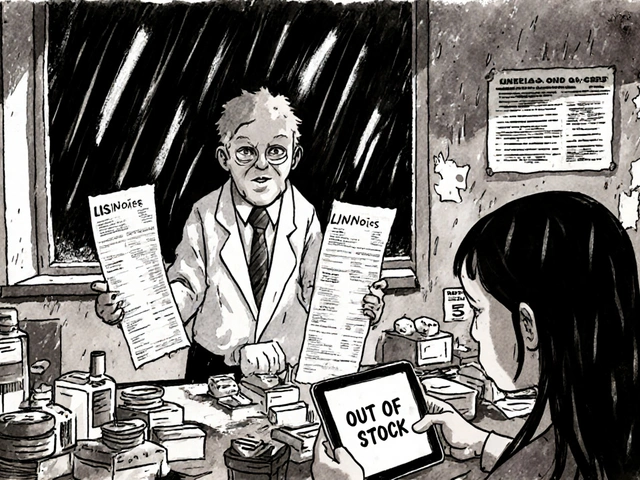Parkinson's Progression Estimator
Calculate Your Treatment Timeline
Based on the ADAGIO clinical trial data, estimate how long you might delay the need for additional Parkinson's medications.
Your Estimated Progression Timeline
Click the button above to see your personalized results
When doctors discuss Rasagiline is a selective MAO‑B inhibitor approved for Parkinson’s disease treatment, patients wonder if it simply eases tremors or actually slows the neurodegenerative process. This article breaks down the science, the clinical proof, and what you should know before starting the drug.
What is Rasagiline?
Rasagiline (brand name Azilect) belongs to the class of monoamine oxidase‑B (MAO‑B) inhibitors. By blocking MAO‑B, the enzyme that breaks down dopamine in the brain, the medication raises dopamine levels and helps improve motor function. Unlike older MAO inhibitors, rasagiline is highly selective for the B isoform, which reduces the risk of dietary tyramine interactions that can cause dangerous blood pressure spikes.
Understanding Parkinson’s Disease
Parkinson's disease is a progressive neurodegenerative disorder characterized by loss of dopamine‑producing neurons in the substantia nigra, leading to tremor, rigidity, bradykinesia, and postural instability. The disease course varies, but most patients experience a steady decline in motor and non‑motor symptoms over years. Slowing that decline is a major therapeutic goal.
How Rasagiline Might Slow Disease Progression
The hypothesis that rasagiline does more than just boost dopamine stems from its neuroprotective properties. Laboratory studies show that the drug can reduce oxidative stress, inhibit apoptosis (cell death), and enhance mitochondrial function. These effects are linked to the drug’s metabolite, aminoindan, which has antioxidant activity.
In animal models of Parkinson’s, rasagiline treatment preserved dopaminergic neurons longer than untreated controls, suggesting a disease‑modifying potential. Translating those findings to humans required well‑designed clinical trials.

Key Clinical Evidence
The most cited evidence comes from the ADAGIO (A Double‑Blind, Randomized, Placebo‑Controlled Study Assessing the Disease‑Modifying Effect of Rasagiline in Early Parkinson’s Disease) trial series, launched in 2007 and published in 2010. Researchers enrolled patients with early Parkinson’s who were not yet on levodopa. Participants received either 1 mg rasagiline, 2 mg rasagiline, or placebo for 72 weeks.
- 1 mg dose: Showed a modest but statistically significant delay in the need for additional dopaminergic therapy compared with placebo.
- 2 mg dose: Did not meet the predefined threshold for disease‑modifying effect, possibly due to a ceiling effect on symptomatic benefit that masked progression data.
A follow‑up extension (ADAGIO‑EXT) tracked patients for an additional two years. Those who started on 1 mg rasagiline continued to demonstrate slower escalation of motor scores (Unified Parkinson’s Disease Rating Scale - UPDRS) than those who began on placebo.
Other trials, like the LARGO and TEMPO studies, examined rasagiline as an add‑on to levodopa in moderate disease. While primary endpoints focused on motor improvement, secondary analyses hinted at reduced “off‑time” and fewer motor fluctuations, indirectly supporting a slower disease trajectory.
Comparison with Other MAO‑B Inhibitors
| Drug | Mechanism Detail | FDA Approval Year | Typical Daily Dose | Evidence for Disease Modification |
|---|---|---|---|---|
| Rasagiline | Irreversible selective MAO‑B inhibition; produces antioxidant metabolite | 2006 | 1 mg | Positive in ADAGIO 1 mg arm (delayed need for levodopa) |
| Selegiline | Irreversible MAO‑B inhibition; requires higher doses for neuroprotection | 1995 | 5‑10 mg | Mixed results; some studies suggest modest slowing, others none |
| Safinamide | Reversible MAO‑B inhibition plus glutamate modulation | 2017 | 100 mg | No definitive disease‑modifying proof yet; improves “on‑time” |
Rasagiline’s advantage lies in its once‑daily dosing, better tolerability, and the most robust trial evidence suggesting a disease‑modifying effect at the 1 mg dose.
Practical Considerations for Patients
- Dosage: The approved regimen is 1 mg taken once daily, typically in the morning.
- Side Effects: Common issues include headache, joint pain, and mild nausea. Serious adverse events are rare but can include hypertension or serotonin syndrome if combined with certain antidepressants.
- Drug Interactions: Because rasagiline is MAO‑B selective, dietary tyramine restrictions are generally unnecessary. However, avoid concurrent use with other MAO inhibitors, SSRIs, or certain opioids (e.g., tramadol) without doctor supervision.
- Monitoring: Physicians usually check blood pressure, liver enzymes, and UPDRS scores every 3-6 months to gauge disease progression and medication safety.
- Cost & Access: As a branded drug, rasagiline can be pricey in some markets, though generic versions are becoming available in the US and Europe.
Before starting rasagiline, discuss your full medication list with a neurologist to rule out contraindications and to set realistic expectations about symptom control and potential slowing of disease progression.

When Rasagiline May Not Be the Best Choice
Patients already on high‑dose levodopa with frequent dyskinesias might benefit more from adjuncts like amantadine or deep‑brain stimulation rather than adding another MAO‑B inhibitor. Likewise, individuals with a history of severe hypertension or who are taking serotonergic drugs may need alternative strategies.
Future Directions in Research
Ongoing studies are exploring rasagiline’s impact on non‑motor symptoms such as sleep disturbances, cognition, and mood. A 2023 phase‑III trial (NEURO‑PRO) is testing whether early‑stage rasagiline combined with lifestyle interventions (exercise, diet) can further extend the “off‑time” free interval.
Another promising avenue is the development of hybrid molecules that combine MAO‑B inhibition with neurotrophic factor delivery. If successful, these could enhance the modest disease‑modifying signal seen with rasagiline alone.
Bottom Line
For many people with early Parkinson’s, rasagiline offers a convenient once‑daily pill that not only smooths out motor symptoms but also carries the most credible evidence of slowing disease progression among MAO‑B inhibitors. Its safety profile, lack of dietary restrictions, and the ADAGIO trial results make it a solid option to discuss with a neurologist, especially if you’re still in the early stages of the disease.
Can rasagiline replace levodopa?
No. Rasagiline is usually added to levodopa or used as an early‑stage monotherapy. It helps increase dopamine levels but does not provide the same potency as levodopa for advanced symptoms.
Is there a dietary tyramine restriction with rasagiline?
Because rasagiline selectively targets MAO‑B, tyramine‑rich foods (cheese, cured meats) are generally safe. Strict restrictions are only needed with non‑selective MAO inhibitors.
What are the most common side effects?
Headache, joint pain, nausea, and occasional dizziness. Serious side effects like hypertension or serotonin syndrome are rare but require immediate medical attention.
Does insurance usually cover rasagiline?
Coverage varies by country and plan. In the US, many private insurers list rasagiline as a preferred drug for early Parkinson’s; checking your formulary is essential.
How long before I see benefits?
Patients often notice improved motor control within 2-4 weeks of starting the 1 mg dose. Evidence of slowed progression emerges over months to years, typically measured by delayed need for additional therapy.






Grace Baxter
October 21, 2025 at 19:23
When the medical community starts heralding rasagiline as the silver bullet for Parkinson's, I can't help but wonder who's really cashing in on that narrative, especially when the same drug is being pushed by multinational pharma giants with deep pockets. Canadians, for instance, have long prided ourselves on a healthcare system that values transparency over profit, yet we see the same glossy press releases wafting across our hospitals as if they were home‑grown victories. The ADAGIO trial, while statistically respectable, was funded in part by the very company that stands to reap billions from every additional prescription, and that should make any critical reader pause. Moreover, the claim that the 1 mg dose delays levodopa initiation is based on a surrogate endpoint that does not directly measure neuronal loss, so the supposed disease‑modifying effect may be an illusion crafted to keep patients on a pill forever. Add to that the fact that the 2 mg arm failed to meet its own pre‑specified criteria, a detail that is often glossed over in popular summaries, and you have a pattern that screams marketing over medicine. From a physiological standpoint, while rasagiline does produce the antioxidant metabolite aminoindan, the concentration achieved in the human brain is a fraction of what was used in rodent models that initially showed neuroprotection. Ethical considerations also arise when we push a drug that can interact dangerously with SSRIs and certain opioids, especially in a population that is already juggling multiple prescriptions. If you look at the broader landscape of MAO‑B inhibitors, selegiline and safinamide have shown mixed results, yet rasagiline still enjoys preferential coverage by insurers, suggesting that lobbying may have a heavier hand than pure science. Canadians deserve a candid discussion that doesn't hide behind the veneer of "once‑daily convenience," a phrase that conveniently masks the fact that convenience is a selling point, not a therapeutic endpoint. In the end, the real question is whether we are truly slowing the inexorable loss of dopaminergic neurons, or merely postponing the inevitable need for higher levodopa doses under the guise of neuroprotection. As someone who grew up watching my grandfather battle Parkinson's without the benefit of such a drug, I remain skeptical of any claim that a single pill can alter the disease trajectory in a meaningful way. Until we have long‑term, unbiased data that unequivocally demonstrate slowed neuronal death, I will continue to advocate for a multimodal approach that includes physiotherapy, diet, and community support, rather than placing all hope on a single pharmacological darling.